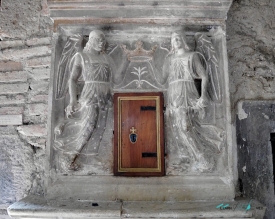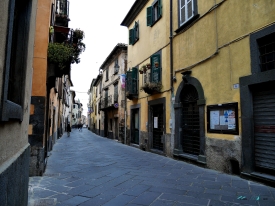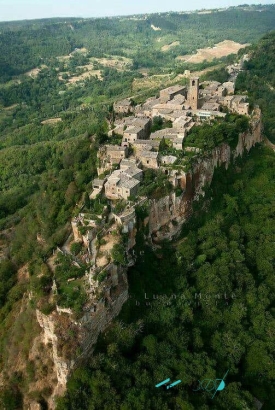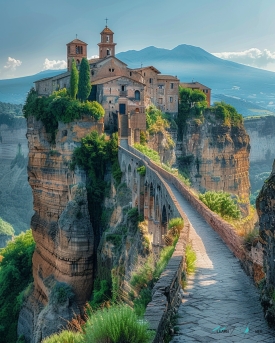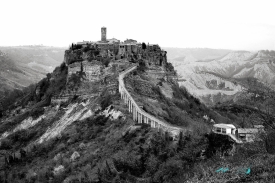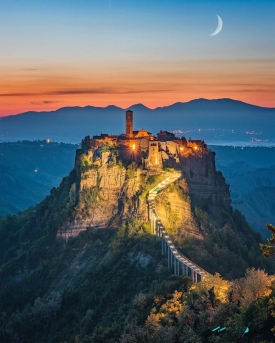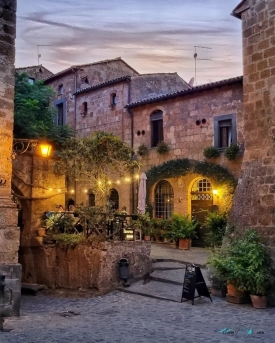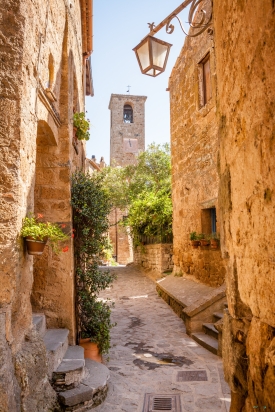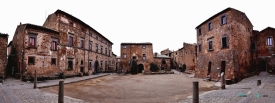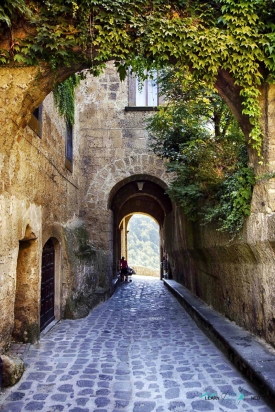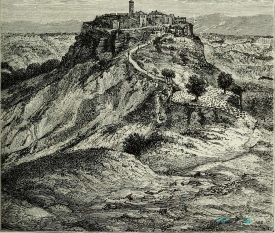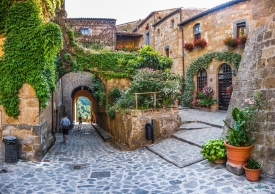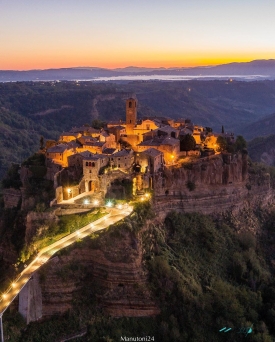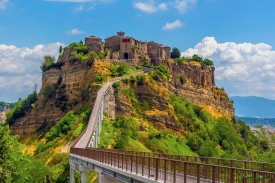ABOUT Civita di Bagnoregio
Civita di Bagnoregio, a small and picturesque hamlet in the province of Viterbo, Lazio, is famously known as "the dying city." This name was popularized by the writer Bonaventura Tecchi, who spent his youth in this village. With only a few residents, Civita is part of "I borghi più belli d'Italia" (The Most Beautiful Villages of Italy), attracting tourists from all over the world due to its scenic beauty and rich history.
Today, Civita is accessible mainly through the Porta di Santa Maria, one of the original five gates that once protected the city. This entrance leads to medieval houses and the village's main square, where the Church of San Donato stands. Visitors can also enter Civita through a tunnel carved into the rock from the Valley of the Calanchi.
When the Romans arrived in 265 BC, they continued the Etruscan engineering efforts to channel rainwater and control the torrents. However, these infrastructures were neglected over time, leading to accelerated erosion and the eventual decline and abandonment of Civita.
Civita’s history is also intertwined with legends, such as the tale of the talking crucifix of San Donato. According to local lore, during a plague in 1499, the crucifix spoke to a devout woman, promising that the epidemic would soon end, which came true shortly after her death.
Although eroded and constantly threatened by landslides, Civita di Bagnoregio has become a must-visit tourist destination. The dramatic beauty of its landscape and its medieval atmosphere have made it a popular film set. Since 2013, visitors have been charged an entry fee to help preserve its fragile environment.
In addition, the Calanchi Valley surrounding Civita has been proposed as a site of community interest due to its ecological and geological significance.
A Town Frozen in Time
Civita di Bagnoregio sits in the dramatic Valley of the Calanchi, between Lake Bolsena and the Tiber Valley. While now isolated and eroded, it was once an essential crossroads. Founded 2,500 years ago by the Etruscans, Civita was located along an ancient road that connected the Tiber to Lake Bolsena. This strategic location allowed the Etruscans to thrive, turning Civita into a prosperous city benefiting from the trade routes of the time.Today, Civita is accessible mainly through the Porta di Santa Maria, one of the original five gates that once protected the city. This entrance leads to medieval houses and the village's main square, where the Church of San Donato stands. Visitors can also enter Civita through a tunnel carved into the rock from the Valley of the Calanchi.
Etruscan and Roman Heritage
The legacy of the Etruscans is still visible in Civita, with its urban structure of "cardi" and "decumani" (main streets), though most of the buildings seen today are from the medieval and Renaissance periods. One of the most fascinating remnants is the "Bucaione," an Etruscan tunnel that cuts through the rock, connecting the town directly to the valley. The ancient tombs carved into the base of Civita’s cliff offer a glimpse into its Etruscan past, though many have been lost due to erosion.When the Romans arrived in 265 BC, they continued the Etruscan engineering efforts to channel rainwater and control the torrents. However, these infrastructures were neglected over time, leading to accelerated erosion and the eventual decline and abandonment of Civita.
Medieval Heritage
Despite the natural challenges, several significant medieval buildings remain in Civita. The Church of San Donato, located in the main square, houses the revered S.S. Crocifisso, which is the centerpiece of an emotional Good Friday procession. Other notable landmarks include the Alemanni Palace, now home to the Geological and Landslide Museum, the Episcopal Palace, and the remains of San Bonaventura’s birthplace.Civita’s history is also intertwined with legends, such as the tale of the talking crucifix of San Donato. According to local lore, during a plague in 1499, the crucifix spoke to a devout woman, promising that the epidemic would soon end, which came true shortly after her death.
Although eroded and constantly threatened by landslides, Civita di Bagnoregio has become a must-visit tourist destination. The dramatic beauty of its landscape and its medieval atmosphere have made it a popular film set. Since 2013, visitors have been charged an entry fee to help preserve its fragile environment.
In addition, the Calanchi Valley surrounding Civita has been proposed as a site of community interest due to its ecological and geological significance.
How to Reach Civita di Bagnoregio
Reaching Civita can be an adventure in itself. From Rome, travelers can take a train to Orvieto, followed by a bus ride to Bagnoregio. From there, Civita is accessible on foot via a pedestrian bridge that offers stunning views of the surrounding landscape.The Best Pictures of Civita di Bagnoregio
Videos of Civita di Bagnoregio









